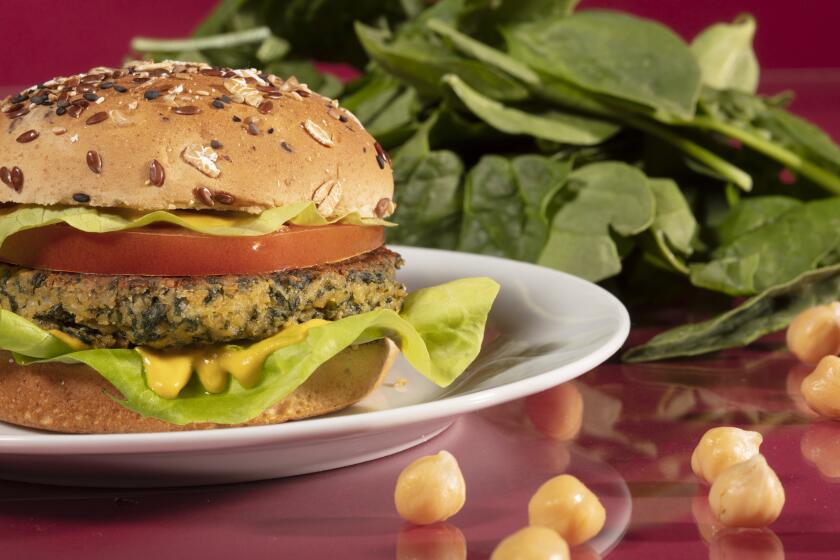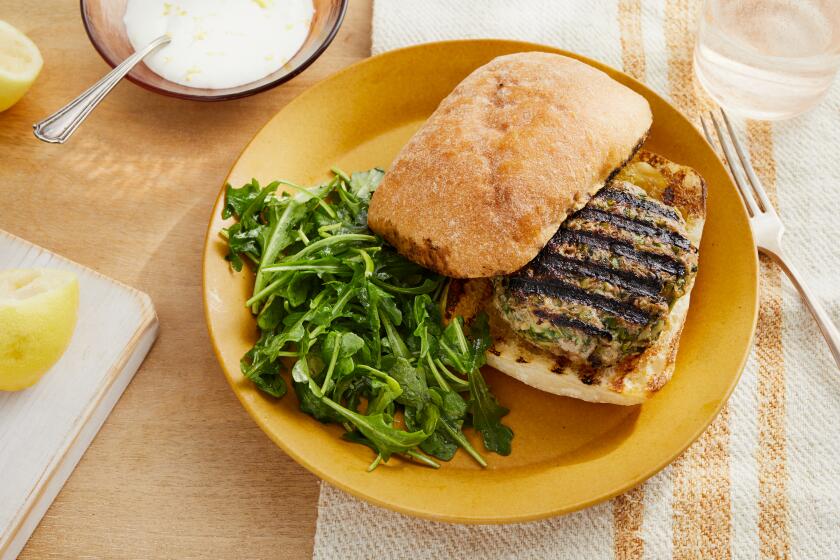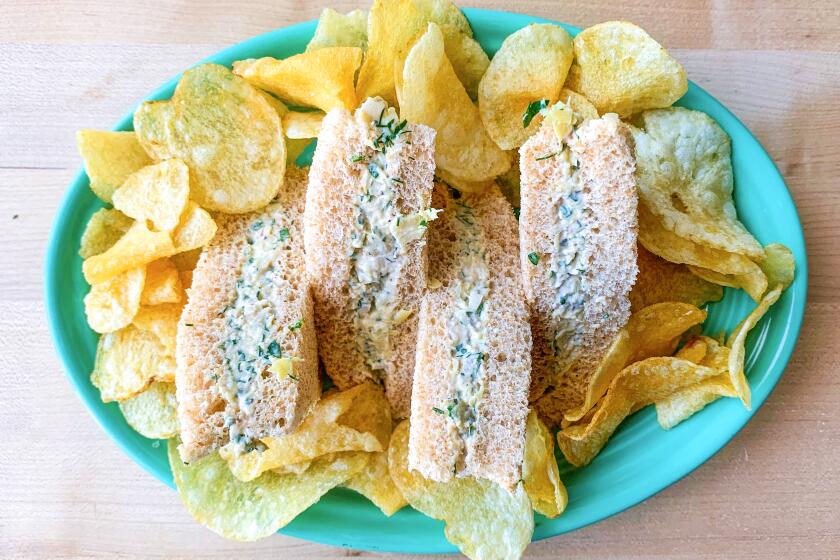The Alex burger

Have you noticed what’s been happening to the hamburger?
In a city that has always been obsessed with them at their most humble--a fact that outsiders can’t stop marveling over--hamburgers are becoming so doted on by chefs, so dolled up with luxury ingredients, so carefully constructed and served that even in Los Angeles they’re a novelty. Restaurants with fine china and long wine lists are adding distinctive signature burgers to their menus, and at prices to make the average In-N-Out fan wince.
Just take the Alex Burger at Alex on Melrose: an over-the-top handful of hand-chopped dry-aged Angus beef, applewood smoked bacon, balsamic-glazed shallots and melted Brie. The price: $18.
Or the $16 Viceroy Burger at Whist in Santa Monica: another hand-chopped Angus affair, but topped with relative restraint with homemade pickles and whole-grain mustard aioli.
The luxury burgers generally fall into two camps. Some emphasize premium meat--foie gras, braised short ribs, steak trimmings (making a burger from trimmings is an old tradition still followed by some steakhouses, such as Taylor’s or Nick and Stef’s). Others concentrate on toppings: farmers market tomatoes, exotic cheeses, marmalade-like onion relishes and homemade relishes such as ketchup, pickles and garlicky mayonnaise.
One thing many of them have in common is that the waiter doesn’t ask, “How would you like that cooked?” The chef’s conception calls for a medium-rare burger, or sometimes even rarer than that.
Where did this all begin? Some point East, to Daniel Boulud, the French-born chef who fatefully introduced the $29 DB burger at DB Bistro Moderne in Manhattan last summer. It’s a 2-inch-thick patty of ground sirloin filled with boned short ribs, foie gras and black truffle. The sandwich, which only the foolhardy will try to eat by hand, created a buzz and now accounts for 25% of the restaurant’s sales.
It’s true that Boulud’s success spurred chefs around the country to try to emulate him. In Dallas, Paris Vendome has rolled out its own $16 burger with short ribs and foie gras in it. “A beautiful, beautiful hamburger,” partner Michel Boutemy de Guislain calls it.
But the fact is, the L.A. burgers don’t show any direct borrowing, and we didn’t really need any outside inspiration. This is a town that has always been serious about hamburgers, a place where people argue about burgers at parties the way Manhattanites argue about Chinese food.
We’ve always had some sort of premium burger. Several local burger chains--Hampton’s, Hamburger Hamlet and Cassell’s--are based on the idea of a premium burger. Back in the ‘80s, a place in Hollywood called the Nucleus Nuance was making the Evolution Burger from a judicious mixture of beef knuckle and veal, ground fresh when the burger was ordered.
Now, the wilting economy seems to be as much a factor in the burger boom as inspired chefs. Hamburgers, which generally cost little to make, leave value-conscious diners feeling sated because of their large size. And for restaurateurs, they carry hefty profit margins.
But they’re the opposite of a cheap, mass-produced burger (and of a diet-conscious burger too, but let’s not even think about that). They have a chef’s personal touch, and they show what professional skill can do with a simple food. Whether you’re relishing a luxurious piece of meat or sinking into a rich blend of beef and plush topping, you’re having a memorable food experience.
Chris Dobbs, a 43-year-old executive vice president at Picture Head, a Hollywood post-production company, has been a burger junkie for as long as he can remember. He gushes with a teenager’s enthusiasm about the burger at Alex.
“The original Tommy’s Burger is pretty great, and In-N-Out is really fresh and tasty, but they don’t hold a candle to the Alex burger,” said Dobbs, who drops by Alex about twice a month for his fix. “It’s the best burger I’ve ever tasted.”
For Alex Scrimgeour, owner and chef of Alex, his namesake burgers have become one of the most popular items on the menu. Made from steak trimmings, the burgers are “a great way to use up all these terrific scraps of prime-aged beef we have but don’t want to throw away,” he says with a laugh.
When Chadwick revived its lunch service two months ago, owner Benjamin Ford and sous chef Andrew Kirschner debated whether burgers should be on the menu. With its blond and dark woods, amber vases and reddish silk pillows along the banquette, the Beverly Hills restaurant hardly looks like a burger joint. And with an average lunch ticket of $25 per person, it’s hardly priced like one.
Nonetheless, Chadwick serves a burger. “Customers kept on asking for one,” Kirschner said.
Chadwick’s chopped-sirloin burger ($12), a half-pound hamburger topped with aged Cheddar, grilled red onions and homemade pickles and served with fries, has struck a chord. The sandwich now accounts for 20% of lunch sales. And next week, the restaurant plans to roll out a second burger, topped with pickled red onions and Maytag blue cheese.
The 8-ounce, $10.95 hamburger served at Reign in Beverly Hills is another hit. It’s topped with lettuce, tomato, red onion and Dijon mustard.
At Jar in Los Angeles, chef and owner Suzanne Tracht serves a burger based on the simplicity principle. Rather than gussy up her half-pound creation with foie gras or short ribs, she garnishes a patty of top sirloin with watercress, balsamic red onions and aioli. “It’s a hamburger, for goodness sake,” Tracht says.
Restaurant regular Bill Beth thinks it’s more than that. The Hancock Park resident and retired investment banker said he considers Jar’s sandwich a bargain, despite its $11 price tag.
“I have no problem paying for the priceless,” he says.
Some people do.
You could order four $2.39 Whoppers and have change left, or nearly five Big Macs at $2.29 each, for the price of a single Jar burger. Simply put, many diners don’t have the stomach for a burger costing $11 or more.
“That’s just too much money,” said Lisa Mamo, a 38-year-old Costa Mesa resident and FedEx employee. “No way. I would never pay that.”
However, a friend recently bought her a $10.95 burger at Cedar Creek Inn in San Juan Capistrano, which Mamo admits was “the best damn burger I ever had.”
The boom in gourmet hamburgers comes at a time when overall burger sales are soggy. In 2001, hamburger sales hit nearly $47 billion, only a 2.7% increase compared to a year earlier. By contrast, the $269 billion restaurant industry grew 4.5%, according to Technomic Inc., a restaurant research and consulting firm in Chicago.
“It used to be that going out to lunch meant getting a burger and fries at a fast-food restaurant,” said Richard Martin, managing editor of Nation’s Restaurant News. “Now there are lots of new menu alternatives out, and lots of different types of restaurants.”
Given its humble history, few could have predicted the rise of the ritzy burger.
The hamburger’s roots are found in Hamburg, Germany, where some sort of pounded beefsteak became popular by the middle of the 19th century, according to “The Dictionary of American Food and Drink.” Beating the fatty meat made it more tender and palatable.
Several U.S. towns, including Seymour, Wis., claim to be the birthplace of the hamburger. But there is little debate that a “hamburger steak” was featured at the World’s Fair in St. Louis in 1904.
A few years later, street vendors began selling ground-beef patties on buns to hungry factory workers, giving the sandwich a blue-collar edge. Since hamburgers were typically made of miscellaneous meat scraps, wisecracking lunch counter waitresses nicknamed them “sweep up the kitchen floor.”
White Castle, followed by Wimpy Grills, McDonald’s, Burger King and other chains later made the cheap but tasty sandwiches available everywhere, says Christopher Muller, a professor of restaurant management at the University of Central Florida in Orlando.
“Up until recently, the hamburger was considered a low-brow product,” he said.
Yes, up until recently.
Balsamic shallot marmalade
Heat the oven to 400 degrees.
Roast the shallots with the butter and salt and pepper to taste in a small ovenproof skillet until golden, about 25 minutes. Shake the skillet frequently. Remove from the oven and place the skillet on the stove top over medium heat. Add the honey and balsamic vinegar and cook until reduced to a syrupy consistency, 6 to 8 minutes. (Makes 1/4 cup.)
Burger
Heat a skillet over medium-high heat. Fry the bacon until crisp, 5 to 6 minutes, then remove to paper towels to drain. Set aside.
Combine the strip and rib-eye steaks and mix in the salt. Shape the meat into 4 (4 1/2-inch) patties.
Melt 1 tablespoon of butter in a large skillet, preferably cast-iron, over medium-high heat. Fry the burgers, 2 at a time, for 3 minutes, then flip. Add 2 slices of the Brie to each patty and cook 3 more minutes for medium. Remove and keep warm; melt the remaining butter in the skillet and repeat with the remaining 2 patties. (You can grill the patties, if you prefer.)
To assemble, place the burgers on the buns. Top them with the bacon slices and Balsamic shallot marmalade, dividing evenly.
Get our Cooking newsletter.
Your roundup of inspiring recipes and kitchen tricks.
You may occasionally receive promotional content from the Los Angeles Times.















